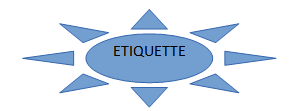Etiquette.
This unit looks at etiquette, which is how you behave with people in social situations.
I. Make a list of as many expressions connected with УetiquetteФ as you can:
II. Read the advice on etiquette. Which advice can you see on the pictures?
|
a. |
УAsk before you take a photo of someone you don't know.Ф Ramir from Algeria |
|
b. |
УNo one arrives for meetings or parties on time. It's OK to arrive half an hour or more late.Ф Sheila from Mexico |
|
c. |
УHaving name cards is essential. Make sure they don't get damaged, and when you give or receive them, use both hands. Read any card you receive very carefully.Ф Li-Soo from Japan |
|
d. |
УWe use the African handshake with people of all races. It shows solidarity and a commitment to nonracial politics. You shake hands in the Western way, then without letting go, you link your thumbs, then return to the Western handshake.Ф Yacine from South Africa |
|
e. |
УI always feel uncomfortable in East Asia because people don't look you in the eye. In my culture, it's important to do so, to show you're being honest.Ф Alex from Romania |
|
f. |
УDon't point. It's rude.Ф Matt from the UK |
|
g. |
УAlways cover your mouth when you yawn.Ф Sheila from Mexico |



III. Work in pairs and talk about the answers to II.
IV. Work in pairs. Discuss your answers to these questions:
|
1. |
Do people ever have conversations with people they don't know? If so, where? |
|
2. |
Which topics of conversation are acceptable? |
|
3. |
Do people ever give up their seat in a bus or train for others? If so, for whom? |
|
4. |
Do people great people they don't know? |
|
5. |
Do people ever talk about how much they earn? |
|
6. |
When someone sits down at a table, does anyone pull out the chair for them? |
|
7. |
When someone comes into a room, do people stand up? |



